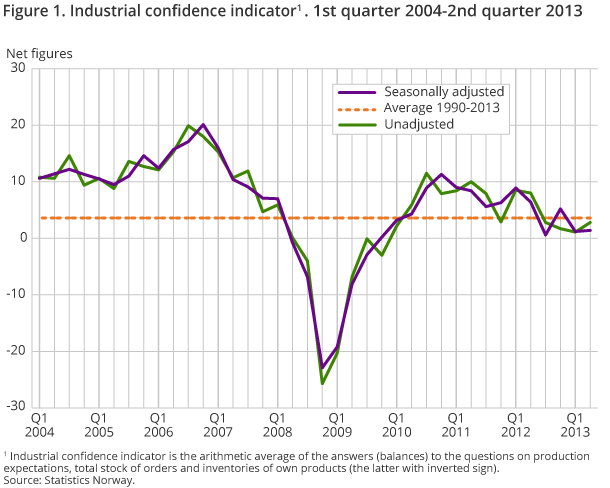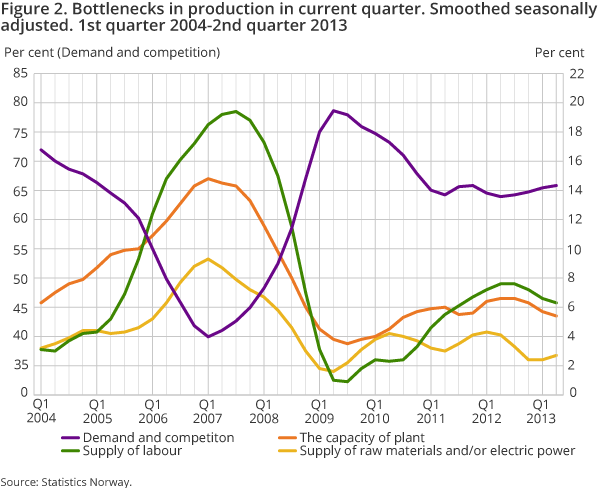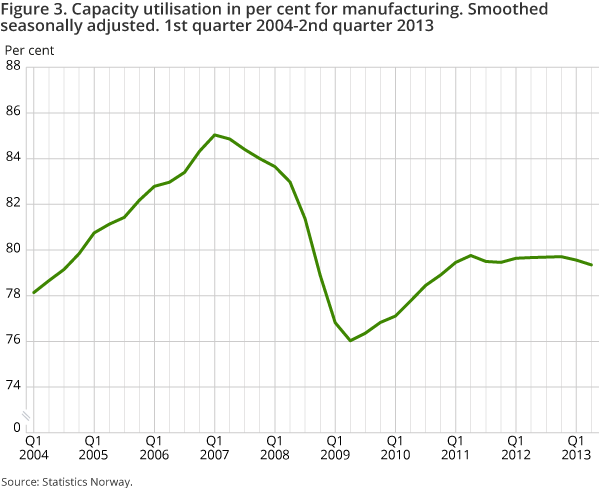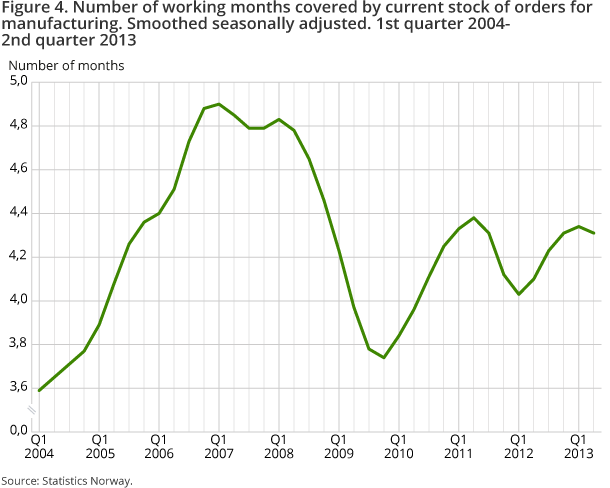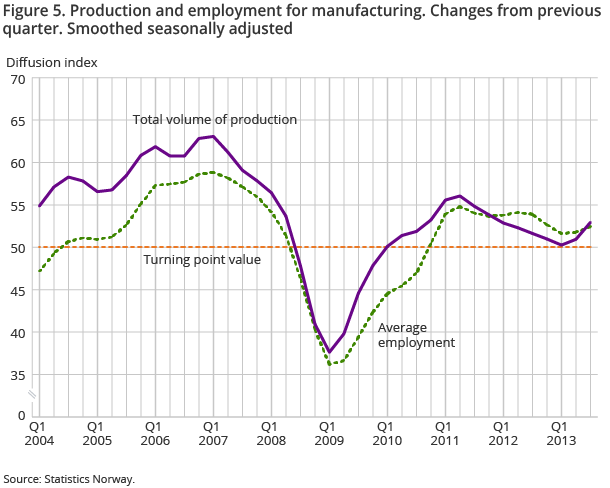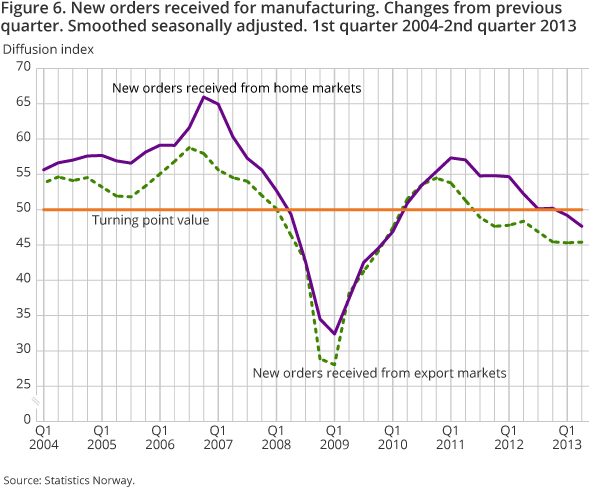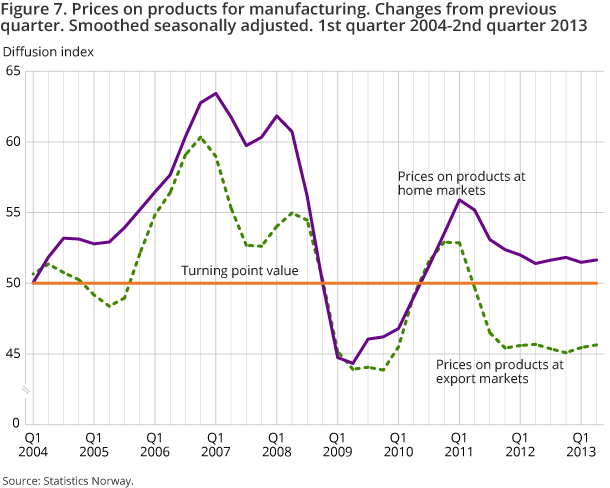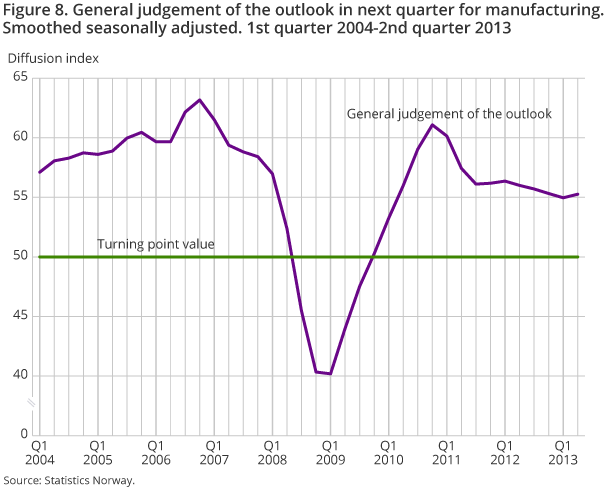Content
Published:
This is an archived release.
Weaker demand from home markets
Norwegian industrial managers report a fall in the supply of new orders from home markets, but the decline has so far had little effect on total output. Large stocks of orders within certain industries explain this result.
| 2nd quarter 2013 | ||
|---|---|---|
| Changes from previous quarter | Expected changes in next quarter | |
| 1A diffusion index is compiled using the estimated percentages on "ups" and "same" according to the formula: (ups + 0,5 * same). The diffusion index has a turning point at 50. An index value above 50 indicates growth in the variable, and opposite for a value below 50. | ||
| Total volume of production | 49.9 | 55.5 |
| Average capacity utilisation | 49.7 | 55.5 |
| Average employment | 51.8 | 49.4 |
| New orders received from home markets | 47.8 | 56.5 |
| New orders received from export markets | 46.3 | 53.7 |
| Total stock of orders | 47.7 | 56.5 |
| Prices on products at home markets | 51.9 | 54.2 |
| Prices on products at export markets | 45.8 | 52.0 |
According to the Business tendency survey for the Norwegian manufacturing industry, there were only minor changes in total output in the second quarter of 2013. However, total employment continued to rise. A strong demand for qualified labour among producers of capital goods was the main reason for this growth. The supply of new orders from home markets fell after a period with strong demand, and the supply of new orders from export markets continued to drop. There was also a further decline in export prices.
The average number of working months covered by the current stock of orders was somewhat higher than in the corresponding quarter of 2012 and lay above the historic average. Large total stocks of orders among suppliers to the oil and gas sector explain this fact. Average capacity utilisation for the Norwegian manufacturing industry is estimated to 79.4 per cent at the end of the second quarter of 2013. International comparisons of average capacity utilisation are available from Eurostat (EU).
Mixed signals for the forthcoming quarter
The general short-term outlook for the third quarter of 2013 is considered to be better. Prospects of growth in output, new orders and market prices support this view. However, in previous surveys the manufacturing leaders have shown a tendency of being more optimistic about the forthcoming quarter than what later has been recorded as the actual development.
The industrial confidence indicator is estimated to be 1 (seasonally-adjusted net figure) in the second quarter of 2013. The result is the same as in the previous survey. Values close to 0 indicate that total output will remain at its current level. International comparisons of the industrial confidence indicator are available from Eurostat (EU), The Swedish National Institute of Economic Research and Statistics Denmark.
Improved demand for basic chemicals
Producers of intermediate goods experienced neutral growth in total output after a period of decline. A somewhat higher demand for basic chemicals seems to explain this fact. However, total employment continued to fall and market conditions were still poor. The situation was particularly challenging for producers of wood and wood products and producers of non-ferrous metals. Average capacity utilisation is estimated to 78.9 per cent at the end of the second quarter of 2013. This is well below the historic average for the industries in question.
The general short-term outlook for the third quarter of 2013 is considered to be better, but fewer respondents share this view, and the investment plans are not changed.
A high rate of employment among producers of capital goods
Producers of capital goods experienced a further increase in output and employment. Huge total stocks of orders among suppliers to the oil and gas sector explain this growth. Usually these are located in labour intensive industries. The supply of new orders continued to fall in home and export markets, but the average number of working months covered by the current stock of orders lay above the historic average for the industries in question. Average capacity utilisation is estimated to 82 per cent at the end of the second quarter of 2013.
The general short-term outlook for the third quarter of 2013 is considered to be better, but fewer respondents share this view.
Lower production of consumer goods
Producers of consumer goods experienced a decline in output and total employment continued to fall.
Weaker demand from export markets and layoffs within competitive industries like production of furniture somewhat explain these results. However, home market prices continued to improve, and export prices also seem to be growing. Average capacity utilisation is estimated to 76.9 per cent at the end of the second quarter of 2013. This result lies below the historic average for the industries in question.
The general short-term outlook for the third quarter of 2013 is considered to be better, and the investments seem to be growing. Prospects of higher demand and improved market prices support these results.
Assessment of industries in Q2 2013 and the short-term outlook
| Industry | Prospects | Background | |||||||||||||||||||||||||||||||||||||||||||||||||||||||||||||||||||||||||||||
|---|---|---|---|---|---|---|---|---|---|---|---|---|---|---|---|---|---|---|---|---|---|---|---|---|---|---|---|---|---|---|---|---|---|---|---|---|---|---|---|---|---|---|---|---|---|---|---|---|---|---|---|---|---|---|---|---|---|---|---|---|---|---|---|---|---|---|---|---|---|---|---|---|---|---|---|---|---|---|---|
Food, beverages and tobacco | + | Minor changes in output and capacity utilization. Higher demand from domestic markets. Improved market prices. The general outlook for Q3 is considered to be better. Upward adjustment of planned investments. | |||||||||||||||||||||||||||||||||||||||||||||||||||||||||||||||||||||||||||||
| Wood and wood products | - | Decline in output, capacity utilization, employment and new orders. Home market prices continued to fall. Minor changes in export prices. The general outlook for Q3 is considered to be neutral. Upward adjustment of planned investments. | |||||||||||||||||||||||||||||||||||||||||||||||||||||||||||||||||||||||||||||
| Paper and paper products | +/- | Growth in output and higher capacity utilisation, but total employment continued to fall. A rise in new orders from export markets. A decline in new orders from domestic markets. Poor market prices. The general outlook for Q3 is considered to be negative. Prospects of a decline in new orders and market prices. Downward adjustment of planned investments. | |||||||||||||||||||||||||||||||||||||||||||||||||||||||||||||||||||||||||||||
| Basic chemicals | +/- | Growth in output and a rise in new orders from export markets. Total employment continued to fall. Poor market prices. The general outlook for Q3 is considered to be neutral. Upward adjustment of planned investments. | |||||||||||||||||||||||||||||||||||||||||||||||||||||||||||||||||||||||||||||
| Non-ferrous metals | -(+) | Decline in output, capacity utilisation and employment. Minor changes in new orders from export markets, but weaker export prices. The general outlook for 3Q is considered to be positive. Prospects of growth in new orders from export markets. Downward adjustment of planned investments. | |||||||||||||||||||||||||||||||||||||||||||||||||||||||||||||||||||||||||||||
| Fabricated metal products | +(-) | Minor changes in output and employment. A decline in new orders. Lower prices in export markets. The general outlook for Q3 is considered to be neutral. Upward adjustment of planned investments. | |||||||||||||||||||||||||||||||||||||||||||||||||||||||||||||||||||||||||||||
| Computer and electrical equipment | + | Growth in output, capacity utilisation and employment. A rise in new orders, but lower market prices. The general outlook for Q3 is considered to be neutral. Downward adjustment of planned investments. | |||||||||||||||||||||||||||||||||||||||||||||||||||||||||||||||||||||||||||||
| Machinery and equipment | + (-) | Minor changes in output and growth in employment. High total stocks of orders, but further decline in new orders. Stable prices in domestic markets. Lower prices in export markets. The general outlook for Q3 is considered to be positive. Prospects of further growth in employment. Downward adjustment of planned investments. | |||||||||||||||||||||||||||||||||||||||||||||||||||||||||||||||||||||||||||||
| Ships, boats and oil platforms | + | Growth in output, capacity utilisation and employment. High total stocks of orders, but further decline in new orders. Lower prices in domestic markets. The general outlook for Q3 is considered to be neutral. Planned investments are not adjusted. | |||||||||||||||||||||||||||||||||||||||||||||||||||||||||||||||||||||||||||||
| Repair, installation of machinery | ++ | Growth in output, capacity utilisation and employment. Higher prices in domestic markets. Negative development in export markets. The general outlook for Q3 is considered to be positive. Prospects of improved conditions in domestic markets. Upward adjustment of planned investments. | |||||||||||||||||||||||||||||||||||||||||||||||||||||||||||||||||||||||||||||
The column for Prospects shows an overall evaluation of the present situation and expected short-term developments using the symbols + and -. The following codes and constellations are used: | ++ -(+) | Very good | |||||||||||||||||||||||||||||||||||||||||||||||||||||||||||||||||||||||||||||
TimelinessOpen and readClose
The survey data was collected in the period between 10 June 2013 and 26 July 2013.
Additional information
The statistics provide current data on the business cycle for manufacturing, mining and quarrying by collecting business leaders’ assessments of the economic situation and the short term outlook.
Contact
-
Edvard Andreassen
E-mail: edvard.andreassen@ssb.no
tel.: (+47) 40 90 23 32
-
Ståle Mæland
E-mail: stale.maeland@ssb.no
tel.: (+47) 95 05 98 88

